Maruti Jimny vs Mahindra Thar comparison: Welcome to the jungle
Can the new Maruti Suzuki Jimny challenge the Mahindra Thar’s position as India’s default choice of off-roader?
Published on Sep 13, 2023 10:53:00 AM
57,943 Views
Follow us on

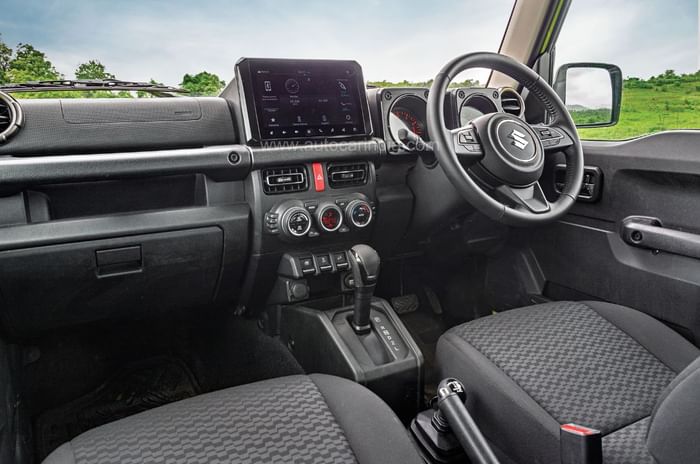
Smart dash is in keeping with Jimny's functional persona.
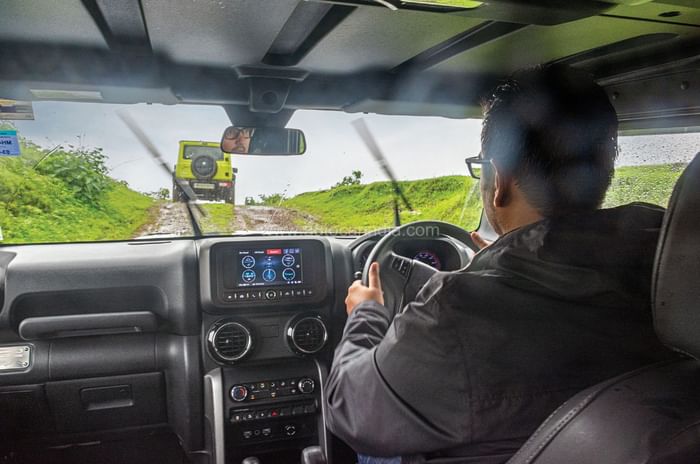
You get a more commanding view of the world from the Thar’s higher-set cabin.
Assembled here are among two of the most talked about vehicles of the past few years. What makes the fact all the more interesting is that they’re off-roaders, a category of vehicle that had long been on the fringes of the mainstream. 2020’s second-gen Mahindra Thar was the catalyst for the change in perception and mass acceptance, and perhaps, as another positive rub-off, gave the ever-calculating folk at Maruti Suzuki the confidence to be adventurous and bring in the fourth-gen Jimny. It’s been quite the wait for the small Suzuki but over the long gestation period, it’s been lengthened and made family-friendly with the addition of a pair of rear doors.
How do the two compare on off-road ability, and everyday concerns such as performance, comfort and practicality? We get our answers over the rainiest week of the year.
Maruti Suzuki Jimny vs Mahindra Thar: off-road experience
These are off-roaders, so the first order of business is to see them in the kind of setting they’re made for. We’re at Learn Off-Road’s expansive training ground outside Mumbai and the plan is to get dirty. 4WD Low engaged, it’s go time.
| Maruti Suzuki Jimny Price, Mileage, Specifications, Features and Variants | |
|---|---|
| Brand | Maruti Suzuki |
| Model Name | Jimny |
| Maruti Suzuki Jimny Price | ₹ 14.87 - 17.23 lakh |
| Maruti Suzuki Jimny Range/Mileage | Petrol : 16.39 - 16.94kpl |
| Maruti Suzuki Jimny Specifications | SUV | 5 doors | 4 seats View All Specs |
| Maruti Suzuki Jimny Features | LED headlight | 9-inch Touchscreen display | 6 airbags View All Features |
| Maruti Suzuki Jimny Variants | 1.5 Petrol Zeta MT | 1.5 Petrol Alpha MT | 1.5 Petrol Zeta AT View All Variants |
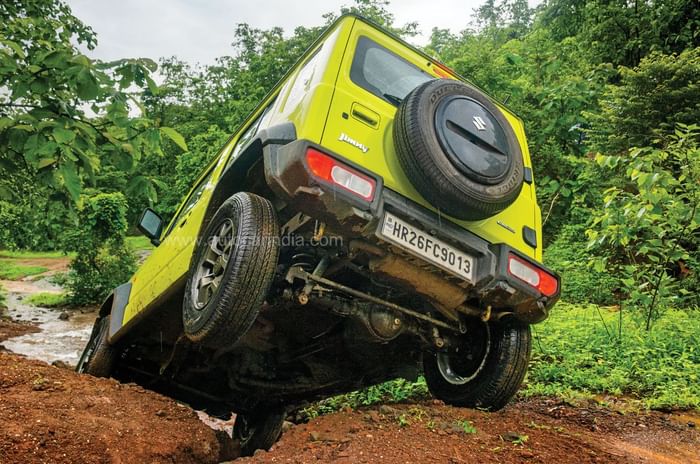
Both models use tough body-on-frame construction, and feature four-wheel drive with low range as part of their arsenals. Hill descent control and brake locking differentials are other features of note. An on-paper comparison will tell you the Thar has far more ground clearance, better approach and breakover angles and can wade through deeper water. And with standard fit all-terrain tyres, the Thar also seems better prepared for the course than the Jimny that’s here on its factory-fit highway terrain tyres. Then again, the Jimny’s tyres also have to deal with a 500kg lighter SUV.

Obstacle one is a steep descent down a narrow, rutted path followed by a climb up a slippery rock. The Jimny’s hill descent control comes across as a bit aggressive (it keeps speed in check well) on the journey down, but the Maruti clambers to freedom up the rock without much fuss. The world looks very different through the windscreen of the Thar. The higher seating gives a better view of the obstacle, but the Thar also feels much larger. The Mahindra is a good few inches wider than the Suzuki, and leaves me with little room to manoeuvre or even change my line if Rahul, my spotter for the day, deems necessary. The Thar’s chunky 255-section tyres do hold gamely through the path and hill descent control maintains pace to a slow crawl.
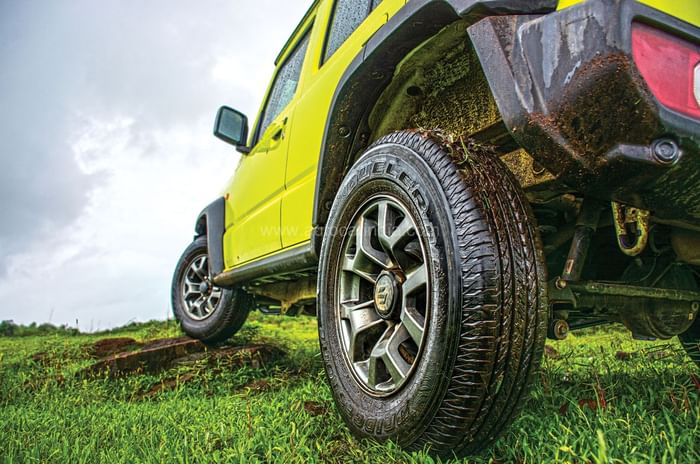
Next up is a dip in two slushy pits separated by an oversized hump. The Jimny feels confident in the entry, and water, and with a bit of added throttle powers out of trouble. The Thar makes light work of the obstacle, though on the climb up the hump, I do feel a harsh snap, which is this 2021 model’s rear mechanical locking differential (MLD) coming into action. Incidentally, the MLD is no longer standard on the Thar 4x4 and is only available as a Rs 20,000 option on the diesel Thar 4x4.
We drive on deeper into the course only to reach a dead end. Except, the dead end is the obstacle. The craggy drop is the remnant of a natural slope washed away by the incessant rains, I’m told. Snail pace, careful steering and immense trust in Rahul is what’s needed. Into the Jimny first. It’s a slow dance of weight transfer as the front right tyre dips down into the path and rear left lifts off. It’s an awkward angle to work through, but at no point is there a fear of the Jimny tipping over – the relatively low roof and low centre of gravity count for a lot. I inch forward and soon all tyres are back on terra firma. The Thar feels different. The wider tracks give it a firmer footing on entry, but I can feel more weight at play as the tyres get air time. Also, since the Thar seats you higher than a Jimny, the roll angle is amplified. For its part, the Thar maintains its composure and makes its way to safety.
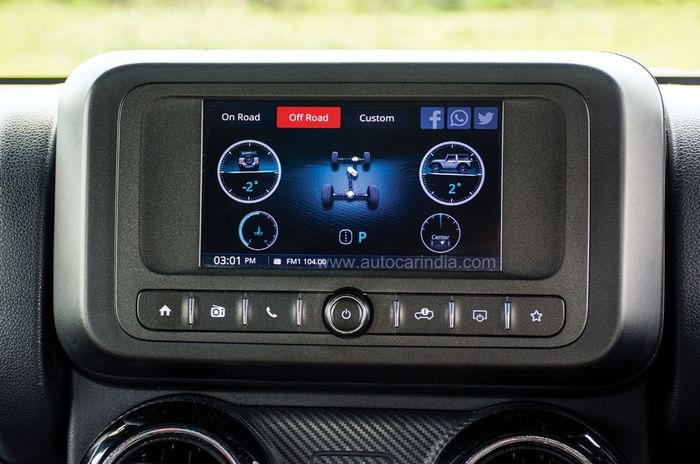
Our outing doesn’t encompass all kinds of off-road settings and scenarios, but there are learnings. The duo are well matched in ability, but take different approaches to off-roading. The Thar with its wide tracks feels confident at all times, but newbies might find the Mahindra’s weight unnerving, especially in articulation type obstacles.The Jimny in that sense is more beginner-friendly. The size will let you sneak into narrower trails and the lightweight assures you that you won’t ever get too badly stuck in trouble. A few helping hands should suffice in most situations. Also amazing is what the Jimny can manage on highway tyres. All-terrain or mud terrain tyres would unlock a whole different level of ability.
Maruti Suzuki Jimny vs Mahindra Thar: dimensions
See the two in the same frame, and you’ll think they’re made to a different scale. They’re about the same length, but the Thar is considerably taller and wider, rides on big 18-inch wheels and generally looks much larger. And I’m talking about the Thar 3-door; a longer 5-door model comes soon. Big on-road presence and macho appeal, the Thar is among the vehicles many will buy for the way it looks than for what it does.
The Jimny, on the other hand, is all about cutesy appeal. It’s got the typical off-roader elements all packed within a small footprint. It’s no wider than a hatchback and the roof isn’t all that high either. The 15-inch rims aren’t large in absolute terms, but they work with the rest of the design. See a Jimny in a bright and happy colour like this Kinetic Yellow, and you’re sure to break into a smile.
Maruti Suzuki Jimny vs Mahindra Thar: interior and features
The size difference also plays out in the interior experience both models offer. The Jimny’s seats are at a comfortable height and the journey to the driver’s seat is made easier thanks to large front doors. Once inside, you’ll find yourself in a compact SUV in the truest sense. The cabin is narrow and you’re sat rather close to your co-driver. Visibility out is good (there’s no seat height adjust though) and you’ll like what you see inside the cabin too. The dash is smart, the chunky controls for the climate control look cool and the orange backlit instruments are a fine link to the Gypsy of old. However, storage space is limited and there are no bottleholders at all.

Getting into the Thar’s higher-set cabin requires the use of the footboard, but you are rewarded by a more commanding driving position. The Thar feels like a larger model and the noticeably wider cabin yields more space between the front seats too. The layered dashboard is interesting in its own right and the buttons for the climate control system are satisfying to use. Quality, as on the Jimny, is decent, and more than acceptable for a rough and tough off-roader. The Thar also packs in bottleholders at the doors, but the lockable glovebox is comically small.
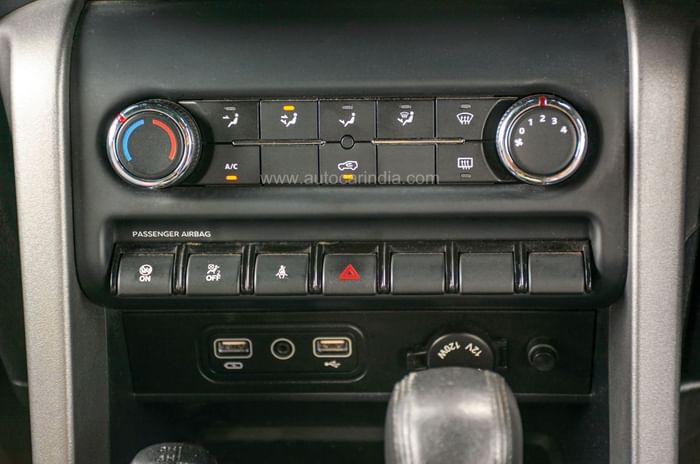
In terms of creature comforts, the Jimny has the clear edge. It’s the only one with auto LED headlights, handy headlight washers, push button start and auto climate control. The Jimny’s 9-inch touchscreen is larger and slicker too, and also packs in wireless Android Auto and Apple CarPlay. The Thar’s 7-inch screen gets the job done though your music will sound distant through the standard sound system. Frustratingly, there’s no rear wiper, which limits visibility on a mucky day.
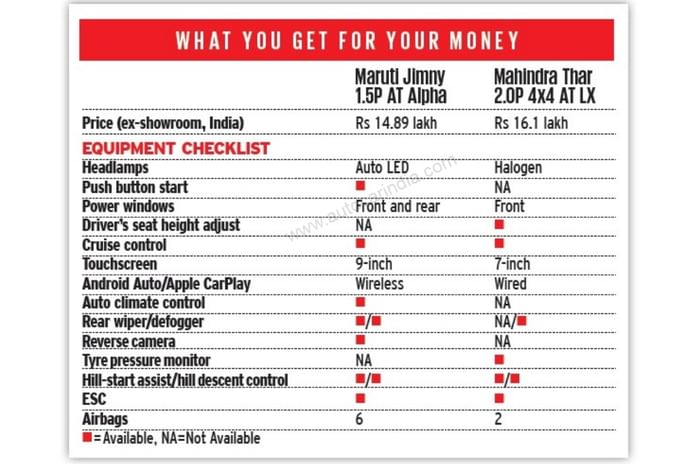
Safety-wise both off-roaders do well to provide electronic stability control, hill-start assist, hill descent control and ISOFIX child seat anchorages. The Jimny does go one up with standard fit six airbags, while the Thar makes do with two.
Maruti Suzuki Jimny vs Mahindra Thar: rear seat experience and boot space
These aren’t models you buy primarily for the rear seat experience, but due weightage has to be given. And it’s here that the Thar 3-door loses big points. Access to the rear seat is from the front passenger door and, resultantly, getting in and out is inconvenient and requires some degree of flexibility. Also, with the large wheel arches eating into space at the back, your two passengers will sit shoulder to shoulder. Knees-up seating and an awkward space to rest your feet also take away from the comfort level.

A small rear door aperture means getting to the Jimny’s rear seat isn’t easiest, but it sure beats having to contort yourself in as you would in a Thar. The rear section of the Jimny’s cabin is best described as cosy, but space and comfort are better than the Mahindra’s. Openable windows are also something Jimny’s rear seat passengers will value.
The Jimny also adds to its tally on practicality with far more room for luggage. The tailgate swings open smoothly to reveal space for two medium-sized suitcases. Access to the Thar’s luggage area requires you to open the heavy tailgate and then lift the windscreen. Your effort isn’t well rewarded because there’s only space for a couple of backpacks. Both models offer the option to fold down the rear seat backrests to open up more luggage room.
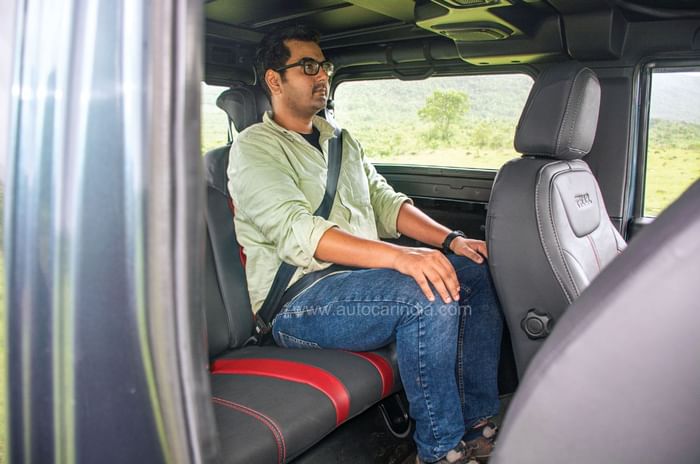
Maruti Suzuki Jimny vs Mahindra Thar: powertrain, performance, fuel efficiency
On to the matter of performance. The Jimny is only available with a 1.5-litre naturally aspirated petrol engine that can be had with a 5-speed manual or a 4-speed automatic gearbox; 4WD is standard, and Maruti has no plans for a rear-wheel-drive-only variant at a lower price point. Mahindra has been more generous in engine and gearbox options. The range starts with the 4x2 RWD whose 1.5-litre diesel engine qualifies the Thar for small car benefits and enables a killer starting price of Rs 10.5 lakh. Then there’s a more powerful 2.2-litre diesel as well as a 2-litre turbo-petrol. In consideration here are the petrol-automatic 4x4s.
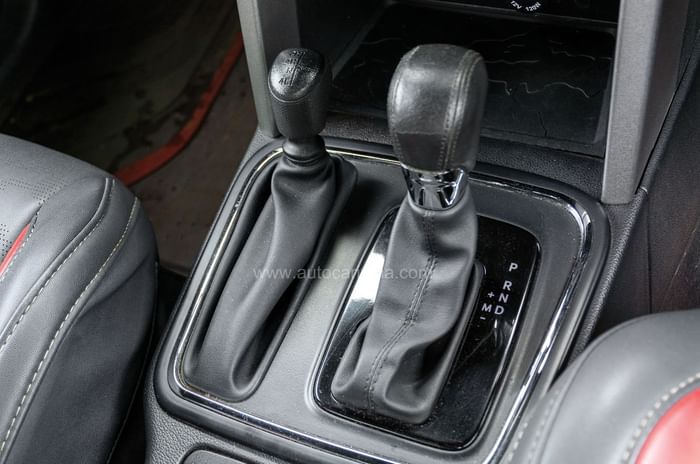
Let’s talk the Thar first, which has the bigger numbers. Its 2-litre mStallion engine makes 152hp and 320Nm. Straight off the bat, this feels like a strong engine. It gives you power when you want it and just feels unstressed at all times. The performance difference to the Maruti is massive, and forget the Jimny, the Thar petrol’s flat-out performance is in the league of midsized sedans, with a 0-100 kph time of 10.2 seconds. Refinement levels are also really good because this is an engine that does its best work quietly. The engine spins at an easy 1,500rpm at 100kph in sixth (versus the Jimny that does 3,000rpm in its top gear). The six-speed automatic gearbox also plays its supporting role really well and you’ll like the fact that it’s got manual control with more intuitive +/- type shifts.
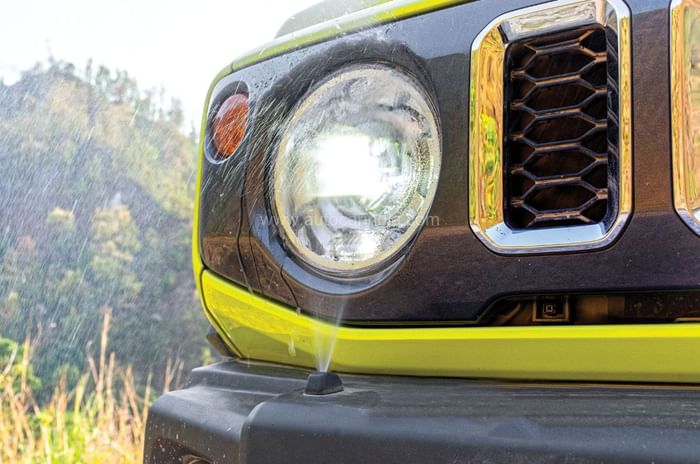
The Jimny’s 105hp and 134Nm, 1.5-litre engine feels humdrum in isolation, and more so if you’ve driven a Thar. Performance is adequate if easy-going driving is all that you’re interested in. But even laid-back drivers will notice that the Jimny just doesn’t have the mid-range to pull off a quick overtake. Mashing down on the throttle has the engine get excited and rev hard, but without a correspondingly urgent build of speed. The issue is exacerbated at higher highway speeds and on steep inclines. Not helping the experience is the old-school 4-speed automatic gearbox that doesn’t like being rushed and works best when you adopt a relaxed driving style. You do get some manual control but the L, 2 and O/D off controls only highlight the gearboxes’ vintage.
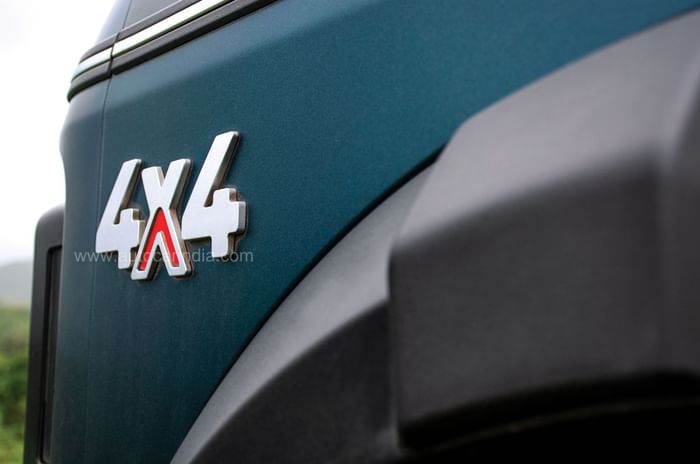
Where the Jimny does have the edge is fuel economy. Over its time with us, the Jimny delivered 8.5-9.5kpl in the city and 10-12kpl out on the highway. Not typical Maruti figures, but reasonable as petrol off-roaders go. The Thar petrol-automatic managed just 7kpl in the city and 9.3kpl on the highway.
Maruti Suzuki Jimny vs Mahindra Thar: ride and handling
There are some surprises when talking ride and handling. For instance, it’s the Thar, and not the Jimny, with the easier-to-twirl steering, smaller turning circle and keener turn-in. The Jimny’s steering is slow geared and needs more lock than you’d expect. This can catch you off guard if you encounter a sudden sharp turn.
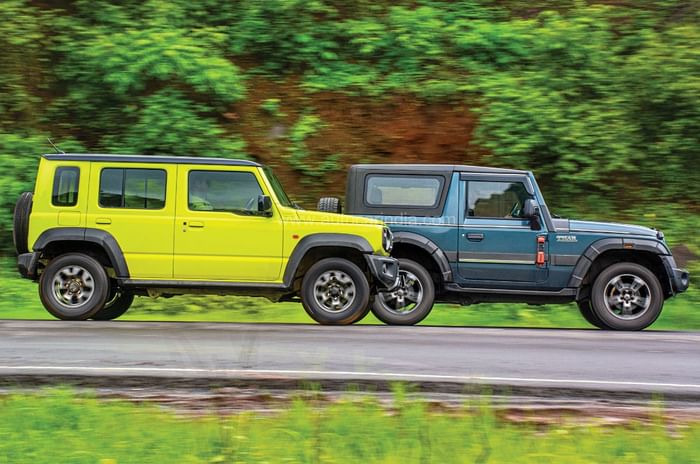
The Jimny acquits itself with a far superior ride. It doesn’t feel bouncy like your typical body-on-frame SUV, and even rounds off the bumps impressively well. Buyers transitioning from a monocoque-bodied hatchback, sedan or SUV won’t feel out of place. In a Thar, you are acutely aware of the surface below you via shakes and jolts from the body. The ride also comes across as busy at higher speeds and it doesn’t help that road shock can be felt through the steering, calling for a firm hand on the wheel at all times. In effect, you’ll be forced to scale back on pace even though the engine is more than ready to take you faster.
Maruti Suzuki Jimny vs Mahindra Thar: price and verdict
The Jimny range starts at Rs 12.74 lakh for the lower-spec Zeta manual, while this automatic in top-spec Alpha trim is yours for Rs 14.89 lakh. The Thar 4x4 range starts at Rs 13.87 lakh and tops off at Rs 16.7 lakh (ex-showroom). The petrol-auto Thar LX 4WD featured here comes in at Rs 16.1 lakh.
Buyers sold on the Thar’s image but who don’t need its off-road ability also have the option of the 4x2 versions, with an enticing starting price of Rs 10.5 lakh. In fact, foregoing 4x4 brings in big savings. The Thar petrol-auto 4x2 costs Rs 2.6 lakh less than the 4x4 version featured here.

After spending quality time with the duo, the big takeaway is that they are very different vehicles even though they come under the same broad category of off-roaders. The Thar has the size and attitude, and backs the tough appeal with power, performance and genuine go-anywhere ability. But it’s not for everyone. The busy ride is something you’ll have to live with and the inconvenient access to the back seat means it’s not ideal transport for the family. The upcoming Thar 5-door should address the latter, but it won’t come cheap.
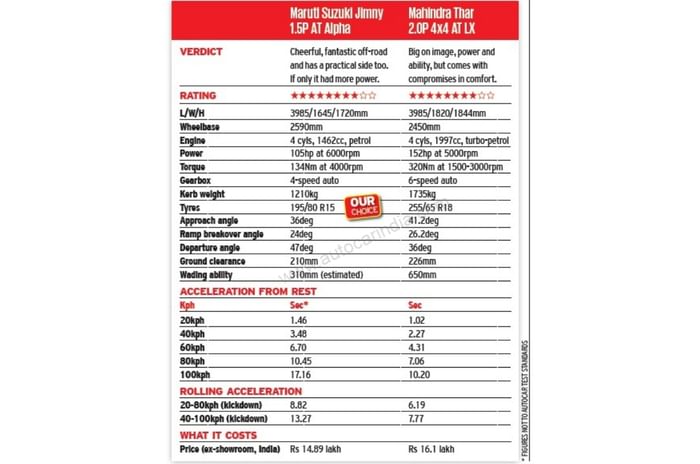
The compact Jimny, on the contrary, isn’t the kind of vehicle to give you an ego boost and it doesn’t score great on price to size either. The lacklustre performance is the big downer. Judged as an off-roader, though, the plucky Jimny has appeal. It’s undoubtedly capable in the rough, but also fits into everyday life with a comfy ride, the practicality of rear doors and a useable boot.
In a nutshell, then, the Thar makes for a great additional vehicle in the household. But as an only vehicle, the Jimny ticks more of the must-have boxes.
Also see:
Maruti Suzuki Jimny vs Mahindra Thar comparison video
Copyright (c) Autocar India. All rights reserved.






Comments
Member Login
Personal Details
No comments yet. Be the first to comment.